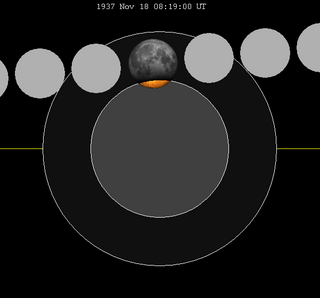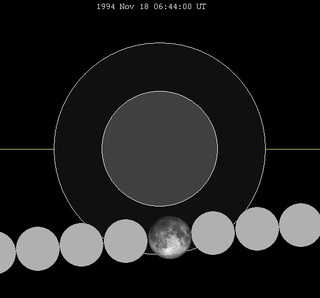
A partial lunar eclipse took place on Thursday, November 18, 1937, the second of two lunar eclipses in 1937. This event took place near perigee, and as described, such event was known as a supermoon.

A partial lunar eclipse took place on Thursday, November 18, 1937, the second of two lunar eclipses in 1937. This event took place near perigee, and as described, such event was known as a supermoon.
| Ascending node | Descending node | |||||
|---|---|---|---|---|---|---|
| Saros | Date Viewing | Type Chart | Saros | Date Viewing | Type Chart | |
| 110 | 1937 May 25  | Penumbral | 115 | 1937 Nov 18  | Partial | |
| 120 | 1938 May 14  | Total | 125 | 1938 Nov 07  | Total | |
| 130 | 1939 May 03  | Total | 135 | 1939 Oct 28  | Partial | |
| 140 | 1940 Apr 22  | Penumbral | 145 | 1940 Oct 16  | Penumbral | |
A lunar eclipse will be preceded and followed by solar eclipses by 9 years and 5.5 days (a half saros). [1] This lunar eclipse is related to two partial solar eclipses of Solar Saros 122.
| November 12, 1928 | November 23, 1946 |
|---|---|
 |  |

A penumbral lunar eclipse took place on Sunday, December 30, 2001, the last of three lunar eclipses in 2001.

A partial lunar eclipse took place on Thursday 5 July 2001, the second of three lunar eclipses in 2001.

A total lunar eclipse took place on Friday 21 January 2000, the first of two total lunar eclipses in 2000.

A total lunar eclipse took place at 0308 UT (GMT) on Thursday, August 17, 1989, the second of two total lunar eclipses in 1989.

A total lunar eclipse took place on Friday, September 27, 1996, the second of two lunar eclipses in 1996, the first being on Thursday, April 4. This is the 41st member of Lunar Saros 127. The previous event is the September 1978 lunar eclipse. The next event is the October 2014 lunar eclipse.

A total lunar eclipse took place on Friday, June 4, 1993, the first of two total lunar eclipses in 1993, the second being on Monday, November 29. The Moon was plunged into darkness for 1 hour and 36 minutes, in a deep total eclipse which saw the Moon 56% of its diameter inside the Earth's umbral shadow. The visual effect of this depends on the state of the Earth's atmosphere, but the Moon may have been stained a deep red colour. The partial eclipse lasted for 3 hours and 38 minutes in total. The moon passed through the center of the Earth's shadow.
A total lunar eclipse took place on Friday, March 24, 1978, the first of two total lunar eclipses in 1978. The moon passed through the center of the Earth's shadow. The Moon was plunged into darkness for 1 hour, 30 minutes and 40.2 seconds, in a deep total eclipse which saw the Moon 45.179% of its diameter inside the Earth's umbral shadow. The visual effect of this depends on the state of the Earth's atmosphere, but the Moon may have been stained a deep red colour. The partial eclipse lasted for 3 hours, 38 minutes and 34.5 seconds in total.
A total lunar eclipse took place on Saturday, May 24 and Sunday, May 25, 1975, the first of two total lunar eclipses in 1975. The Moon was plunged into darkness for 1 hour and 28 minutes in a deep total eclipse which saw the Moon 43% of its diameter inside the Earth's umbral shadow. The visual effect of an eclipse depends on the state of the Earth's atmosphere, but the Moon may have been stained a deep red colour. The partial eclipse lasted for 3 hours and 35 minutes in total. Occurring only 4.4 days after perigee, the Moon's apparent diameter was 0.7% larger than average. The moon was 377,010 km from the Earth at greatest eclipse.

A partial lunar eclipse took place on Saturday, April 15, 1995, the first of two lunar eclipses in 1995, the second being with a penumbral lunar eclipse on Sunday, October 8.
A total lunar eclipse took place on Monday, October 28, 1985, the second of two total lunar eclipses in 1985, the first being on May 4, 1985.

A penumbral lunar eclipse took place on Friday, November 18, 1994, the second of two lunar eclipses in 1994, the first was a partial lunar eclipse on Wednesday, May 25.

A penumbral lunar eclipse took place on Thursday, June 27, 1991, the second of four lunar eclipses in 1991. The moon entered the Earth's penumbra for about 3 hours, and was difficult to see. This lunar eclipse is the predecessor of the Solar eclipse of July 11, 1991.

A penumbral lunar eclipse took place on Friday, July 26, 1991, the third of four lunar eclipses in 1991. This was the 2nd member of Lunar Saros 148. The previous event was on 15 July 1973, and the 1st eclipse of the series. The next event was on 6 August 2009.
A total lunar eclipse took place on Saturday, September 16, 1978, the second of two total lunar eclipses in 1978. The Moon was plunged into darkness for 1 hour, 18 minutes and 39 seconds, in a deep total eclipse which saw the Moon 32.683% of its diameter inside the Earth's umbral shadow. The visual effect of this depends on the state of the Earth's atmosphere, but the Moon may have been stained a deep red colour. The partial eclipse lasted for 3 hours, 27 minutes and 11.6 seconds in total.
A partial lunar eclipse took place on Tuesday, March 13, 1979, the first of two lunar eclipses in 1979. The Moon was strikingly shadowed in this deep partial eclipse which lasted 3 hours, 17 minutes and 40.6 seconds, with 85.377% of the Moon in darkness at maximum.

A total lunar eclipse took place on Monday, May 13, 1957, the third of fourteen total lunar eclipses of Lunar Saros 130. The Moon was plunged into darkness for 1 hour and 18 minutes, in a deep total eclipse which saw the Moon 30% of its diameter inside the Earth's umbral shadow. The visual effect of this depends on the state of the Earth's atmosphere, but the Moon may have been stained a deep red colour. The partial eclipse lasted for 3 hours and 32 minutes in total.
A partial lunar eclipse took place on Sunday, April 12, 1903. This nearly total lunar eclipse of Saros cycle 130 preceded the first total eclipse on April 22, 1921. The Moon was almost covered by the Earth's shadow in a very deep partial eclipse, which lasted 3 hours and 17 minutes. With 96.77% of the Moon in shadow at maximum eclipse, this was quite a memorable event.
A partial lunar eclipse took place on Thursday, March 12, 1914.
A partial lunar eclipse took place on Thursday, May 13, 1976, the first of two lunar eclipses in 1976, the second being a penumbral lunar eclipse on November 6, 1976. At maximum eclipse, a small bite out of the Moon should have been visible. The eclipse lasted for 1 hour, 15 minutes and 23.8 seconds, with just 12.17% of the Moon in shadow at maximum. Occurring only 1.1 days after perigee, the Moon's apparent diameter 5.4% larger than average.

A partial lunar eclipse took place on Thursday, March 2, 1961, the first of two partial lunar eclipses in 1961.